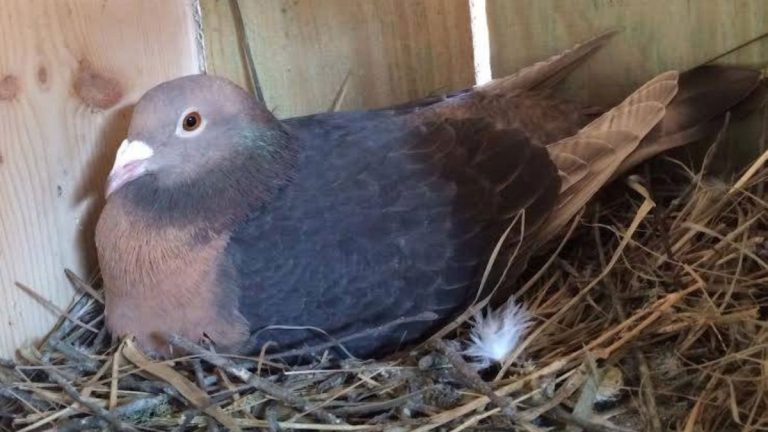The Endangered Pink Pigeon: A Comprehensive Guide
Endangered pink pigeon refers to pigeon species which are at risk of extinction. Due to public unawareness or extreme weather, their habitats are at significant risk. That’s why it’s time to take major conservation steps to protect this pigeon species.
But how to protect the endangered pink pigeon? Rehabilitating natural plantations in their habitats is an effective step in this regard. Also, removing invasive plants, captive breeding, and supplementary feeding play significant roles in conserving the bird.
In this article, we will discuss their habitats, feeding, and mating behavior, and threats to their habitats. You will also learn about conservation efforts and potential challenges. So, keep reading till the end.
Habitat And Behavior
Generally, pink pigeons prefer evergreen forests as their habitat. You can also find them in coastal forests too. Besides, they also like to live in forests or plantations with adjacent open areas.
Usually, they love to live in low-canopied forests with an elevation of 300m. Yet, you will find them all over the island, even on the lowlands. As a result, they will play a vital role in seed dispersal and plant pollination all over the island. This will help to maintain a balance in the Mauritius ecosystem.

Pink pigeons are primarily a Mauritius endemic species. They also live in Isle aux Aigrettes, a tiny predator-free island off the East Coast.
According to a 2016 report, you will find their wild population in 5 places. 4 of those locations are in the Black River Gorge National Park. The last location is the Isle Aux Aigrettes.
Behavioral Characteristics Of Pink Pigeon

To understand the pink pigeon behavior and characteristics, you need to know about their feeding, mating, and social behavior. Here are those:
- They are not migratory birds. Yet, they take short flights between their roosting and foraging areas
- This bird species feeds on plants, buds, flowers, leaves, seeds, etc.
- Pink pigeons love to feed in groups or pairs on the forest floor or on the trees’ canopy
- They usually search for food by moving or turning over the leaves of forest ground
- These pigeons mainly show monogamous mating behavior. That means they live with the same partner until death
- During their mating season, the male members will court female members with a “step and bow” approach
- They are territorial and protect their mating area from other mating pairs
- Their advertising calls for the territories will be multiple “coos”
- During the flight, the sound will be something like “hoo hoo”
- Also, while courting the female, the male will make sounds like “coo-woo-wah”
Threats To Pink Pigeon Habitats
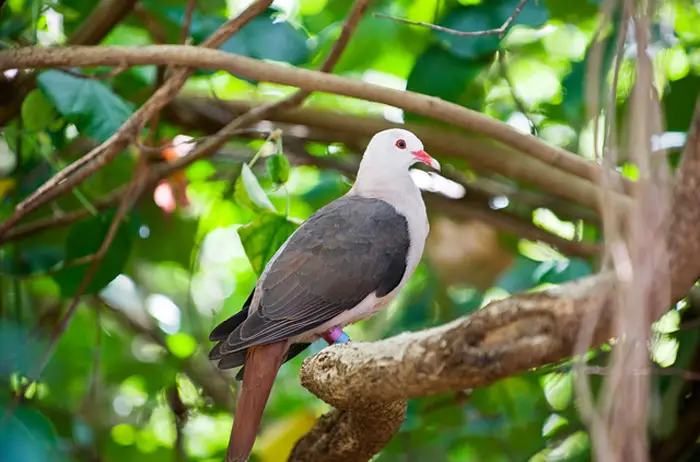
Habitat loss of this bird species is the main reason for their rusk of existence. Here are some significant threats to their habitats:
- Forest destruction by mankind causes massive habitat loss
- Many invasive species of plants like Privet ligustrum Robustum Subsp. Walkeri, Chinese guava, etc., reduce the native plantations. As a result, the suitable nesting and foraging areas for them get reduced. This hampers their foraging and breeding habits
- Climate changes cause extreme weather conditions and calamities in their native habitats. Tropical cyclones are most familiar among those calamities. This cyclone damages their eggs, chicks, and even their nests
Conservation Efforts
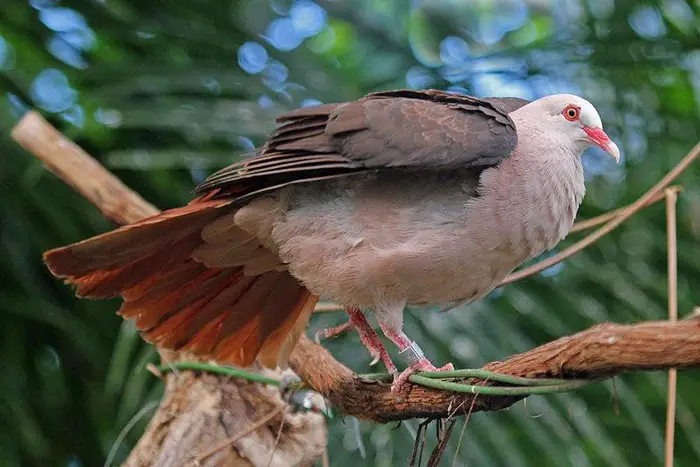
Various conservation organizations took steps to conserve the population of pink pigeons. Here are some of their efforts:
- First, restoration of their habitat is necessary to protect the birds from extinction. Some organizations are focusing on this type of island conservation
- Removal of invasive plants from the pink pigeons’ native habitats
- Rehabilitation and propagation of native plantations
- Captive breeding is another effective step. Wildlife organizations took this bird species and bred them in captivity or in zoos. During this period, the breeders and squabs get all facilities for generating a healthy population
- After producing a safe amount of the bird’s population, those organizations reintroduce them to their wildlife habitats
- Due to the reduced food sources in their wild habitats, organizations took steps for supplementary feeding
- Those organizations are also making efforts for continuous population monitoring. This helps them detect any disease and mutation spread among the bird’s population
Successes And Challenges Of Conservation Efforts
In 2000, the IUCN announced the pink pigeon as a critically endangered species. In 1991, the population of this pigeon species was only 10 individuals. The Mauritian Wildlife Foundation played a vital role in the captive breeding and reintroducing of this pigeon species.
Ultimately, it successfully reached a population of up to 400 individuals in 2018. During this period, the IUCN announced it as an endangered birds species. But currently, the population of these birds is relatively stable, and now IUCN has termed the species as a vulnerable species.
Though the conservation efforts effectively increased the number of pink pigeon species, there are some challenges too. Those are:
- They need to monitor the feeding station closely to prevent the risk of disease spread
- During the reintroduction of this species, it’s challenging to locate a suitable new location
- It’s also complex to understand how the meta-population of this species will function after reintroduction
- Managing and population monitoring for the long term is also a complex task
Importance Of Community Involvement And Public Awareness
Those pink pigeon conservation efforts can’t be fruitful without public awareness and community involvement. The reasons are:
- The conservative efforts’ ultimate success can’t be solely possible by the Maturity Wildlife Conservation Organization. So, combined contributions of different foundations and organizations are necessary
- Public awareness is necessary to reduce the deforestation rate
- The conservative program will require a large amount of money. Different Trust foundation needs to supply the funding for this program
- Genetic observation and research are also mandatory for a more effective conservation program. So, contributions from research institutions are also necessary
Threats And Challenges
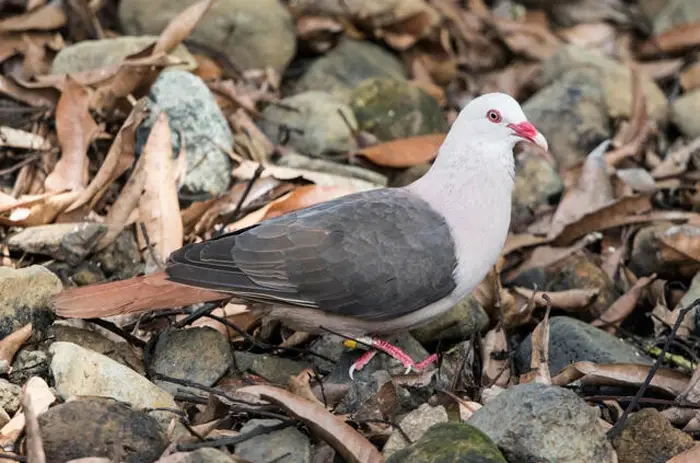
A few prime pink pigeon threats are:
- The reduction in the native forest in Mauritius causes difficulty in their nesting area and food availability
- A significant threat to their existence is an increase in their predator groups. Mainly, rats, feral cats, mongoose, and crab-eating macaques are on their predator lists
- The food station for supplementary feeding poses the risk of spreading diseases like trichomoniasis. This spread of disease will even result in bird extinction
Challenges Faced By Conservation Organisations
Therefore, during the conservation program, the organizations will face many challenges. Such as:
- Due to breeding between closely related individuals, their genetic diversity is decreasing
- In breeding system also causing various harmful mutations among the generations
- Breeding between closely related pink pigeons resulted in reduced reproduction abilities and an increased mortality rate
- Different types of disease may spread during captivate or supplementary feeding. This type of disease could be fatal and may reduce longevity
Impact Of The Pink Pigeon’s Decline On the Mauritius Ecosystem
Protecting the pink pigeons is necessary as it plays a vital role in the Mauritius ecosystem. If the population of this avian species declines over time, the long-term impacts on the ecosystem will be:
- A large group of predators will face food scarcity, as these birds are their prime prey
- These pigeons play an essential role as pollinators in the ecosystem. So, due to the decline in the endangered bird species, the seed dispersal and pollination of plants will also get reduced
- The avian ecology and biodiversity of Mauritius will also get imbalanced over time
Supporting Pink Pigeon Conservation
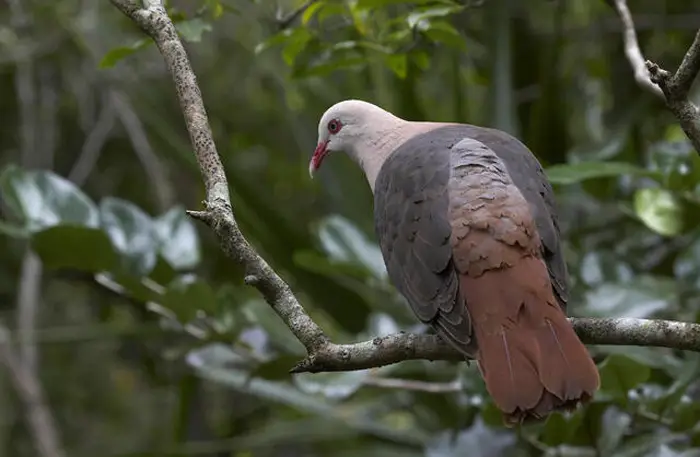
Generally, conservation efforts will only be fruitful when individuals support this program voluntarily. Here are some ways how individuals can contribute to this program:
- All individuals must support the organization and foundations working for the conservation program
- For this, you also need to contribute to their funding
- Besides, you can also contribute by fulfilling your duty to wildlife conservation
- You shouldn’t cut or plant invasive trees on pink pigeons’ native habitats
Benefits Of Supporting Pink Pigeons

You should support the conservation efforts of the pink pigeons because they play an essential role in the Mauritius ecosystem and science. For example:
- The pink pigeon population indicates the changes in climate, environmental stability, contaminants, avian diseases, etc.
- This conservation provides an excellent opportunity to study and learn the ecological behavior and pertaining methods to the population dynamics of this unique species
- Conservation of this species can protect and keep balance in the overall Mauritius wildlife and ecosystem
Therefore, supporting the conservation program arranged by different organizations will take minimal effort. But this program will protect this unique pigeon species from extinction risk.
Protecting this type of endangered bird will provide more benefits, including biodiversity protection. So, everyone should take their part and contribute to the pink pigeon conservation programs.
If you’re interested in exploring more pigeon species, you may also want to learn about the Tooth-billed Pigeon and Rock Pigeons. Our article on the Tooth-billed Pigeon delves into the unique characteristics and conservation status of this fascinating bird. Additionally, our article on Rock Pigeons provides insights into the natural history, behavior, and urban adaptations of these common city-dwelling pigeons.Conclusion
Multiple organizations and foundations are working hard to conserve the endangered pink pigeon. Besides their efforts, social awareness and participation of individuals are also mandatory for long-term success.
Therefore, individuals must participate in the bird conservation campaign and program. You can further research the conservation methods to better understand this program.


